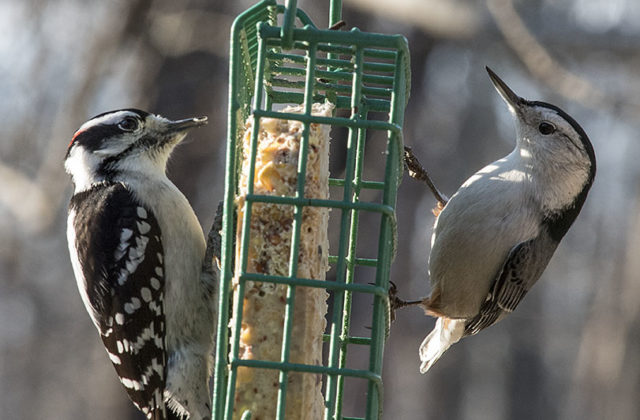Aton Forest Holds Annual Census of Early Winter Birds
By Wiley Wood
Although she has been taking part in Christmas Bird Counts for over 50 years, when Ayreslea Denny describes her bird encounters on the morning of December 31 in Aton Forest, her voice is full of excitement. “The number of birds we got was just unbelievable,” she said.
A small group, led by Aton Forest’s director, John Anderson, set out from the forest’s headquarters on North Colebrook Road shortly after daybreak. “The idea,” says Anderson, “is to see how many birds you can observe in a day.”
Almost immediately, the group spotted a northern shrike. A predatory songbird that nests in Canada’s far north, the shrike is fairly rare in Norfolk, according to Anderson. Its appearance is unremarkable—gray back, white undersides and a black mask and wings—but, being bigger than most songbirds and slender in outline, it was quickly noticed by Fran Zygmont, a noted local birder, in a bush near the forest office.
Shrikes are known for killing more than they can eat and storing their prey by impaling them on thorns or barbed wire.

The red-bellied woodpecker is a year-round resident in Norfolk.
Farther along, Zygmont identified the call of the red crossbill, a series of short, hard “jips.” In October of this year, according to Zygmont, crossbills flooded into the area just as the seeds of the white pine matured, most likely because the pine seed crop farther north had failed. Where pine seeds were plentiful in Litchfield County, crossbills have been locally abundant.
“We all got to see the crossbills,” said Denny. “There were three of them.” They are stocky, finch-like birds, rusty red in color, that specialize in eating the seeds of conifers, using their unusually shaped beaks to pry the cones open.
“I saw a song sparrow in the swamp,” said Denny. “Then we heard a pileated woodpecker—they make a very strong sound, “yuck-yuck-yuck.” The female came right in and entered her nesting hole in a nearby tree. The male stood as sentinel about 100 yards away the whole time we were there.”
When bird activity slowed—the temperature was hovering around 20 degrees—the group moved on, and Zygmont began making owl calls. “Fran is a good caller,” says Anderson, “he can make lots of bird calls by mouth, and he also has an app on his phone.”
The “hoo-aw” of the barred owl brought many small birds rushing toward the group to mob what they thought was a large predator. “There were chickadees, a nuthatch, blue jays,” said Anderson. “You can use the call of any owl except the great horned owl. The great horned makes all the other birds shut up.”
He cautions that the tactic, though effective, should be used sparingly, especially on very cold days, as it diverts birds from feeding and robs them of energy they would otherwise use for survival.
Between 4:30 a.m., when the first group went owling in the pre-dawn cold, and 4 p.m., when the last group returned, the Aton Forest birders recorded 204 individual birds, belonging to 25 species. The data was uploaded to Aton’s website and to eBird, which maintains a running list of local bird sightings in the U.S.
The Christmas Bird Count is a citizen scientist project started more than 100 years ago by the Audubon Society. Its database, charting early winter bird populations throughout the Western Hemisphere, is used by researchers studying the status and ranges of birds.
An official Christmas Bird Count is held in Litchfield by the Litchfield Hills Audubon Society, and another, captained by Norfolk resident Roland Denny, centers on Barkhamsted. Aton Forest’s census is more informal, although Ayerslea Denny, who participated in all three counts, calls it “the best ever.”
Aton Forest welcomes participants in its Christmas Bird Count. It plans other citizen scientist projects in upcoming months, including its annual porcupine and beaver census. Details are posted on the Aton website.
Photos by Bruce Frisch. Top: Both the downy woodpecker, left, and the white-breasterd nuthatch, shown here feeding on suet, were recorded by Aton Forest during its Christmas Bird Count.

